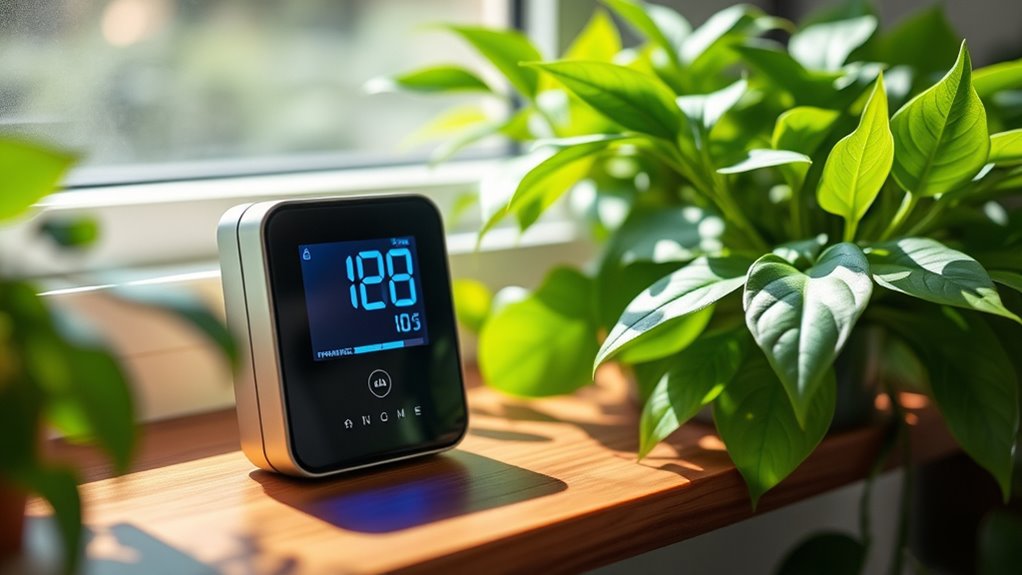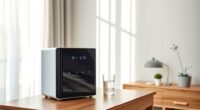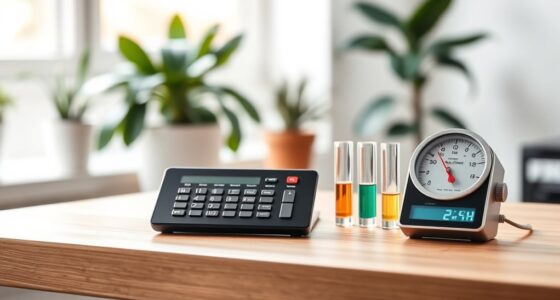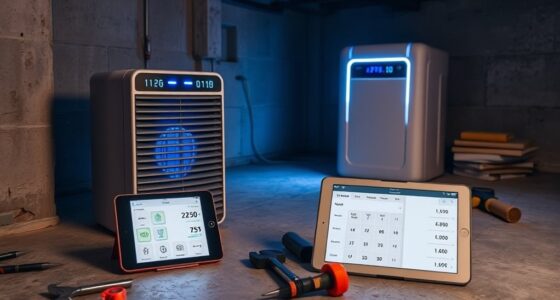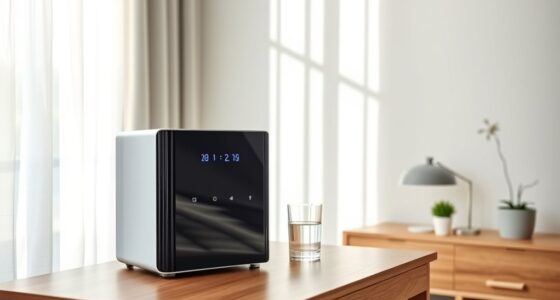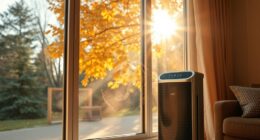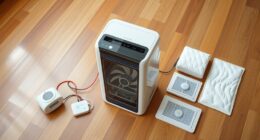To find your home’s comfort zone, aim for an humidity range between 30% and 50%. Use a reliable humidity range finder to monitor moisture levels accurately. Adjust your humidifiers or dehumidifiers accordingly to maintain this ideal zone, which helps prevent mold, mildew, and dryness. Knowing your target range keeps your environment comfortable and safe year-round. Keep exploring to discover how smart devices can make humidity control even easier.
Key Takeaways
- Use a reliable humidity range finder to measure current moisture levels accurately.
- Maintain indoor humidity between 30% and 50% for optimal comfort and safety.
- Adjust humidifiers or dehumidifiers based on readings to stay within the ideal range.
- Monitor seasonal changes to prevent mold, mildew, and structural damage.
- Incorporate AI analytics for proactive, precise humidity management tailored to your home.
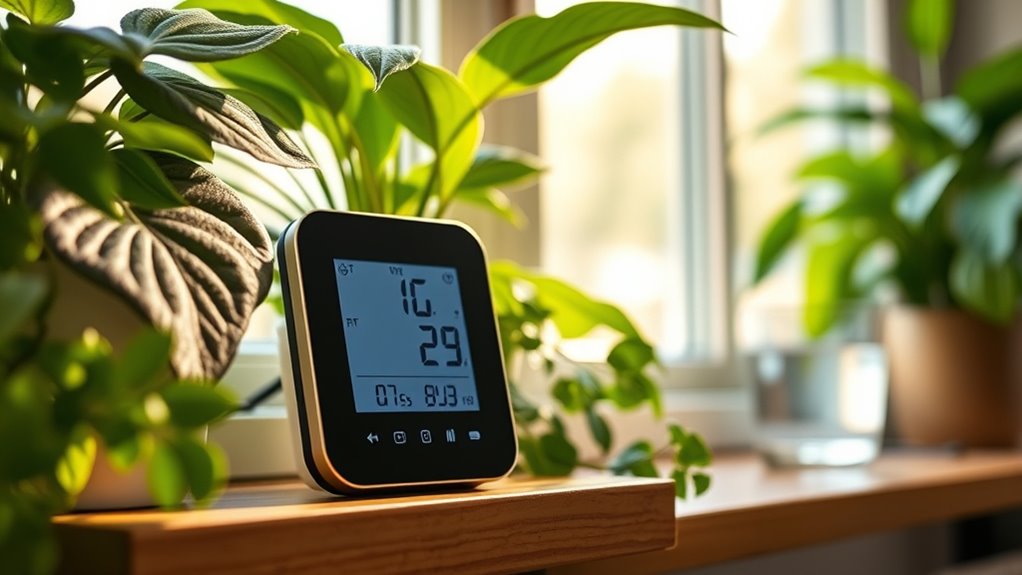
Maintaining the right humidity level is essential for comfort, health, and preserving your belongings. When you focus on humidity control, you’re actively managing moisture levels in your home environment, which has a direct impact on how comfortable and safe you feel. Too much moisture can lead to mold growth, musty odors, and even respiratory issues, while too little dries out your skin, irritates your eyes, and can cause static electricity to build up. To strike the perfect balance, you need to identify your home’s ideal humidity range—typically between 30% and 50%. Knowing this range allows you to adjust your heating, cooling, and ventilation systems accordingly, ensuring that moisture levels stay within a healthy, comfortable zone.
Using a reliable humidity range finder helps you monitor these moisture levels accurately. Once you understand the current humidity, you can take targeted actions to bring it into the ideal range. For instance, during dry winter months, running a humidifier can add necessary moisture, preventing the air from becoming too arid. Conversely, in humid summer conditions, a dehumidifier can help remove excess moisture, reducing the risk of mold and mildew. By keeping a close eye on your humidity levels, you avoid the guesswork involved in maintaining a comfortable environment. You’ll also protect your furniture, electronics, and personal belongings, which can be damaged by prolonged exposure to improper moisture levels.
Additionally, AI-powered data analytics can assist in tracking and predicting humidity fluctuations, allowing for more proactive management. It’s important to remember that humidity control isn’t just about comfort—it’s about health too. Proper moisture levels help prevent the growth of mold spores and dust mites, which thrive in damp environments and can trigger allergies or asthma. Maintaining the right humidity can also improve sleep quality, as overly dry or humid air can disrupt your breathing and cause discomfort. When you use a humidity range finder regularly, you develop a better understanding of your home’s unique needs, allowing you to make smarter adjustments. This proactive approach saves you money over time by avoiding costly repairs caused by excess moisture or dryness.
Frequently Asked Questions
Can Adjusting Humidity Levels Reduce Allergies?
Yes, adjusting humidity levels can reduce allergies by preventing mold growth and improving respiratory health. When you keep humidity between 30-50%, you create an environment less favorable for mold, dust mites, and other allergens. This helps you breathe easier and minimizes allergy symptoms. Regularly monitoring and adjusting your home’s humidity guarantees a healthier space, especially if you or your family members suffer from allergies or respiratory issues.
How Often Should I Calibrate My Humidity Meter?
You should calibrate your humidity sensor about once a year to guarantee device accuracy. Coincidentally, I just checked mine after noticing inconsistent readings—calibrating improved its performance. Regular humidity sensor calibration keeps your device precise, helping you maintain a comfortable environment. If you experience fluctuating readings or suspect inaccuracies, calibrate more often. Keeping your sensor accurate ensures you’re always aware of your home’s comfort zone and can adjust humidity levels accordingly.
Are There Specific Humidity Levels for Children’s Rooms?
For children’s rooms, aim for a humidity level between 40-60%. Maintaining this range supports child safety by reducing risks of mold and dust mites, which can impact air quality. You should regularly monitor and adjust humidity to keep it within this comfortable zone, ensuring your child’s environment remains healthy and safe. Proper humidity levels promote better sleep, breathing, and overall well-being for your little ones.
Does Humidity Affect Indoor Plants Differently?
Humidity definitely impacts your indoor plants differently. When humidity levels fall outside their tolerance, you might notice plant health decline, leaves browning or wilting. If you’re unaware of each plant’s humidity tolerance, it’s easy to overlook these signs. Keeping humidity just right guarantees your plants thrive, preventing stress and encouraging lush growth. Pay close attention to their specific needs—your plants will thank you with vibrant, healthy foliage.
What’s the Best Way to Maintain Stable Humidity?
To maintain stable humidity, you should regularly monitor your home’s levels with a hygrometer. Use a humidifier and dehumidifier to add or remove moisture as needed, ensuring they’re well-maintained for peak performance. Proper humidifier maintenance prevents mold and bacteria growth, while dehumidifier benefits include reducing excess moisture. Adjust these devices based on seasonal changes and indoor activities, keeping your environment comfortable and healthy.
Conclusion
Now that you know the ideal humidity range for your home, imagine the comfort waiting just beyond that perfect zone. But what if your current levels are hiding a hidden problem? Don’t wait until discomfort or damage strikes—keep a close eye on your humidity. The secret to lasting comfort and health might be just a simple adjustment away. Are you ready to discover what’s really lurking in your indoor air? The answer could change everything.
